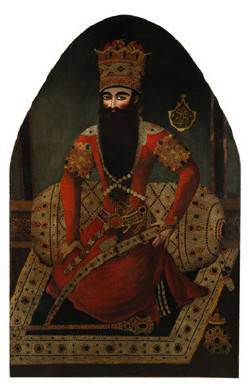
A rare 14th-century Nasrid period Gold and Enamel Royal Belt Buckle from Al-Andalus (Estimate: in excess of £600,000)

Attributed to Mizra Baba: Portrait of Fath ‘Ali Shah Qajar
SOTHEBY’S FORTHCOMING ARTS OF THE ISLAMIC WORLD SALE IS SET TO BE ITS MOST IMPORTANT EVER PRESENTED
Estimated to realise in excess of £9 million
]]>
April 2nd 2008 – 2007 WAS A RECORD BREAKING YEAR for Sotheby’s in the field of Islamic Art. The company witnessed sales of Islamic, and Modern and Contemporary Arab and Iranian Art achieve a remarkable annual total of over £20 million – the best-ever for sales in this category – as well as achieve the highest ever total for A rare 14th-century Nasrid period Gold and Enamel Royal Belt Buckle from Al-Andalus (Estimate: in excess of £600,000) a dedicated sale of Islamic Art**. Now, Sotheby’s London is delighted to present the most important Arts of the Islamic World Sale it has ever staged on Wednesday, April 9, 2008.
The auction will comprise more than 400 lots of rare and important works of art, including metalwork, manuscripts, weaponry, ceramics, textiles and paintings that span from the 7th century through to the 16th, 17th, 18th and 19th centuries. The sale, which is expected to realise in excess of £9 million, is set to attract enormous interest from collectors and connoisseurs of Islamic Art across the globe.
The most important work in the upcoming sale will be an extremely rare 14th-century gold and enamel Royal Belt Buckle (illustrated front page) from Al-Andalus, which was produced during the Nasrid period (AD 1230-1492) in Granada, Spain. The buckle, which is inscribed with ‘Glory to our lord, the Sultan’, is an extraordinary example of the art of the goldsmiths in 14th-century Islamic Spain. Its remarkable quality, the technique used by the goldsmith and the royal inscription all suggest that the buckle must have been worn by the sultan himself or someone very close to him. Only three other enamelled pieces from 14th-century Nasrid Spain, which are made entirely of gold, are known to exist and the offered lot, which is of museumquality and outstanding importance, is estimated to realise in excess of £600,000.
One of the star works among the paintings on offer is a portrait of Fath ‘Ali Shah Qajar (illustrated left) seated against a jewelled bolster on a pearl edged rug, which is attributable to Mirza Baba and the court workshop in Qajar, Persia. The oil on canvas, in the manner of Mirza Baba and the early Qajar style, dated circa 1798, demonstrates areas of enormous artistic strength; the sensitively rendered hands, the facetted jewels, the foreshoretening of the body all point to the hand of a master, and the high detail in the jewel studs of the Shah’s robe, the faceted diamonds modelled in light and shade. The sketchy background however suggests a collaboration of artists which in this case is likely to be Mirza Baba and an anonymous artist, or artists of the court workshop. Such detail provides a fascinating insight into the production of court portraits. The portrait is estimated at £400,000- 600,000.
Follow us on:


